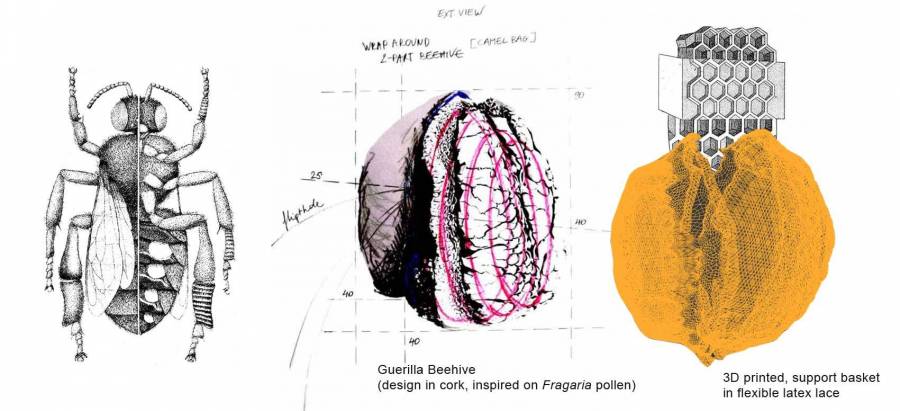The story behind the concept
The project ‘Guerilla Beehives’can have an exemplary meaning for the audience if it comes to the public perception sustainability. It is a collaboration between the arts, design and science.
This is the end of the anthropocene. We imagine an ecosystem where all actors collaborate to keep up the resilience of the system. As artists, gardeners, makers and thinkers, we collaborate with animals, plants, insects and bacteria.
Therefore we design Guerilla Beehives, supportive shelters for intelligent bee swarms, with the parameters given by those swarms. In return, the bees provide us with information on the ecosystem in order to understand this in a better and more useful way. Driven by the intelligence and complexity of the Super Organism (bee swarm) we discuss and explore in a democratic way. This is not a study of-, but a discovery together with ‘the other organism’. This collaboration should lead to a more diverse and thus more resilient system, post human and post anthropocentrism. Animal politics taken into account. We go for an embodied experience, non-linear, immanent and interacting with the non-human other.
guerilla beehive design

The ‘wrap-around’ design consists of 2 parts: 1 big bag which is hosting the nest of the bee colony, and 1 smaller bag which is housing the observation technology – at the same time, the smaller bag acts as the counter weight for the bigger bag.
The hive-part has a content of 40 liters. The outer skin is printed in rubber. It has an irregular spiky form which is inspired by the surface of a seedpod and it has qualities of camouflage when fixed to a tree. The rubber spikes adapt to variable weather conditions. At the inside, the nest-volume is lined with cork. Between the outer and inner skin there is a vacuum (similar to cell-membranes) filled with air. This air-filled space adjusts the thermoregulation in the hive and helps the bees to maintain the ideal temperature of 35°C. The cork wall has micropores (inspired by the pores in radiolaria) which allow for a humidity regulation around 55%. Both outer and inner wall are designed to manage the beehive’s homeostasis.
Follow the updates on the design development on my research-wiki:
https://research.annemariemaes.net/doku.php?id=guerillabeehive-researchpage
https://research.annemariemaes.net/doku.php?id=guerillabeehive-projectpage
Guerrilla Beehive – the Project
Bee colonies are threatened in all industrialized nations. Given that the survival of bees is crucial for human sustainability, there is a great urgency to improve by all means the ways in which colonies could thrive.
The Guerilla Beehive proposes a shelter for swarming bee colonies and supports the bees in their roles as pollinators and caretakers of biodiversity rather than as honey producers. In this project, bees, humans and plants – are working together to assure a sound basis for the further development of our ecosystem.
The design of the Guerilla Beehive is inspired by nature. The content (± 40 liters) responds to the nest-needs of a bee colony living in the wild, and the mobile architecture makes it easily deployable on different spots in public space, hence its name: the Guerilla Beehive. The hive can be grafted on the wall of a building or wrapped around the branch of a tree in a park (the bees prefer a ‘higher’ spot, south-east oriented). The beehive has been enhanced with a sensor network in order to monitor the health of the colony without interference and thus allow better care. The Guerilla Beehive is made out of smart organic materials with usefull properties in respect to temperature fluctuation, humidity and ventilation. The hive has a high tactile potential; the flexible rubber of the outer skin and the warm and soft cork of the inner skin invite to touch and feel. All materials are biodegradable. Once the colony decides to leave the hive, the Guerilla Beehive will fall as a ripe apple from the tree and decompose completely. It is a cradle to cradle design.
